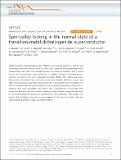Spin-valley locking in the normal state of a transition-metal dichalcogenide superconductor
Abstract
Metallic transition-metal dichalcogenides (TMDCs) are benchmark systems for studying and controlling intertwined electronic orders in solids, with superconductivity developing from a charge density-wave state. The interplay between such phases is thought to play a critical role in the unconventional superconductivity of cuprates, Fe-based, and heavy-fermion systems, yet even for the more moderately-correlated TMDCs, their nature andorigins have proved controversial. Here, we study a prototypical example, 2H-NbSe2, by spin-and angle-resolved photoemission and first-principles theory. We find that the normal state,from which its hallmark collective phases emerge, is characterised by quasiparticles whose spin is locked to their valley pseudospin. This results from a combination of strong spin-orbit interactions and local inversion symmetry breaking, while interlayer coupling further drives a rich three-dimensional momentum dependence of the underlying Fermi surface spintexture. These findings necessitate a re-investigation of the nature of charge order and superconducting pairing in NbSe2 and related TMDCs.
Citation
Bawden , L , Cooil , S P , Riley , J M , Collins-McIntyre , L J , Sunko , V , Hunvik , K , Leandersson , M , Polley , C M , Balasubramanian , T , Kim , T K , Hoesch , M , Wells , J W , Balakrishnan , G , Bahramy , M S & King , P D 2016 , ' Spin-valley locking in the normal state of a transition-metal dichalcogenide superconductor ' , Nature Communications , vol. 7 , 11711 . https://doi.org/10.1038/ncomms11711
Publication
Nature Communications
Status
Peer reviewed
ISSN
2041-1723Type
Journal article
Description
We gratefully acknowledge support from the Engineering and Physical Sciences Research Council, UK (work at St Andrews under Grant No. EP/I031014/1 and work at Warwick under Grant No. EP/M028771/1) and the International Max Planck partnership. PDCK acknowledges support from the Royal Society through a University Research Fellowship. MSB was supported by the Grant-in-Aid for Scientific Research (S) (No. 24224009) from the Ministry of Education, Culture, Sports, Science and Technology (MEXT) of Japan. LB, JR, and VS acknowledge studentship funding from EPSRC through grant nos. EP/G03673X/1, EP/L505079/1, and EP/L015110/1, respectively. The experiments at MAX IV Laboratory were made possible through funding from the Swedish Research Council and the Knut and Alice Wallenberg Foundation.Collections
Items in the St Andrews Research Repository are protected by copyright, with all rights reserved, unless otherwise indicated.

